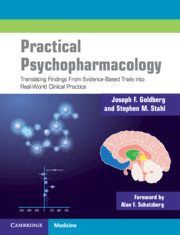 Practical Psychopharmacology
Practical Psychopharmacology Book contents
- Practical Psychopharmacology
- Practical Psychopharmacology
- Copyright page
- Dedication
- Contents
- Foreword
- Preface
- Abbreviations
- Part I General Principles
- Part II Targets of Pharmacotherapy
- 13 Disordered Mood and Affect
- 14 Disorders of Impulsivity, Compulsivity, and Aggression
- 15 Psychosis
- 16 Deficit States and Negative Symptoms
- 17 Anxiety
- 18 Addiction and the Reward Pathway
- 19 Trauma and Post-traumatic Stress Disorder
- 20 Personality Disorders and Traits
- 21 Cognition
- 22 Putting It All Together
- References
- Index
18 - Addiction and the Reward Pathway
from Part II - Targets of Pharmacotherapy
Published online by Cambridge University Press: 19 October 2021
- Practical Psychopharmacology
- Practical Psychopharmacology
- Copyright page
- Dedication
- Contents
- Foreword
- Preface
- Abbreviations
- Part I General Principles
- Part II Targets of Pharmacotherapy
- 13 Disordered Mood and Affect
- 14 Disorders of Impulsivity, Compulsivity, and Aggression
- 15 Psychosis
- 16 Deficit States and Negative Symptoms
- 17 Anxiety
- 18 Addiction and the Reward Pathway
- 19 Trauma and Post-traumatic Stress Disorder
- 20 Personality Disorders and Traits
- 21 Cognition
- 22 Putting It All Together
- References
- Index
Summary
Addictions are, fundamentally, disorders of the reward pathway. Clinicians, patients or family members are sometimes dissatisfied with the pronouncement that an addiction is its own diagnosis, preferring instead to search for additional psychiatric conditions (such as mood or anxiety disorders) from which addiction behaviors might be secondary offshoots – perhaps in part because of the more extensive range of pharmacotherapy options available to treat mood and anxiety disorders than addictions. True dual diagnoses certainly exist, in which mood or thinking problems occur as free-standing entities, but unless they chronologically antecede an addiction it becomes difficult if not impossible to discriminate them from the symptoms caused by repeated intoxication and withdrawal states. Still, intrinsic disorders of the reward pathway can be complex and often inherently involve problems with mood, thinking, perception, impulse control, self-regulation, compulsivity, and a host of psychopathology dimensions described in earlier chapters.
- Type
- Chapter
- Information
- Practical PsychopharmacologyTranslating Findings From Evidence-Based Trials into Real-World Clinical Practice, pp. 425 - 446Publisher: Cambridge University PressPrint publication year: 2021
